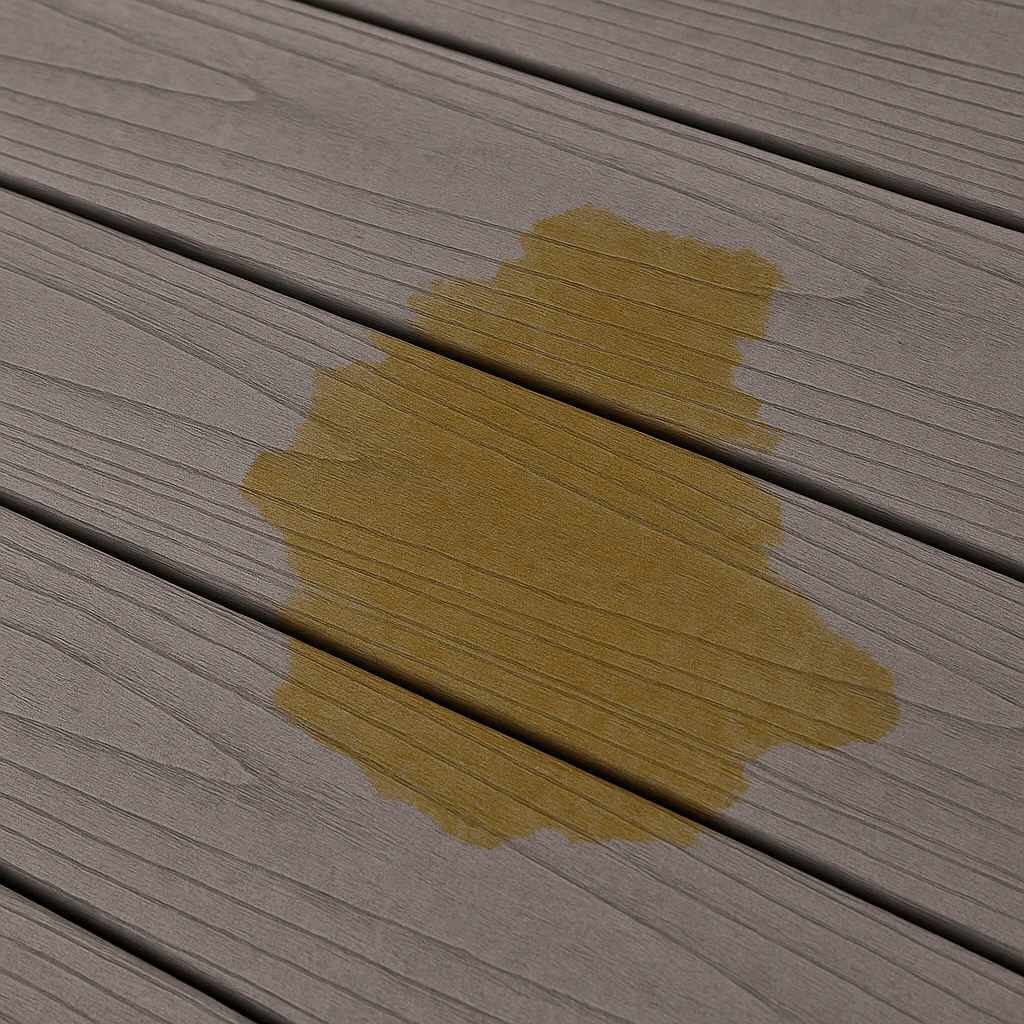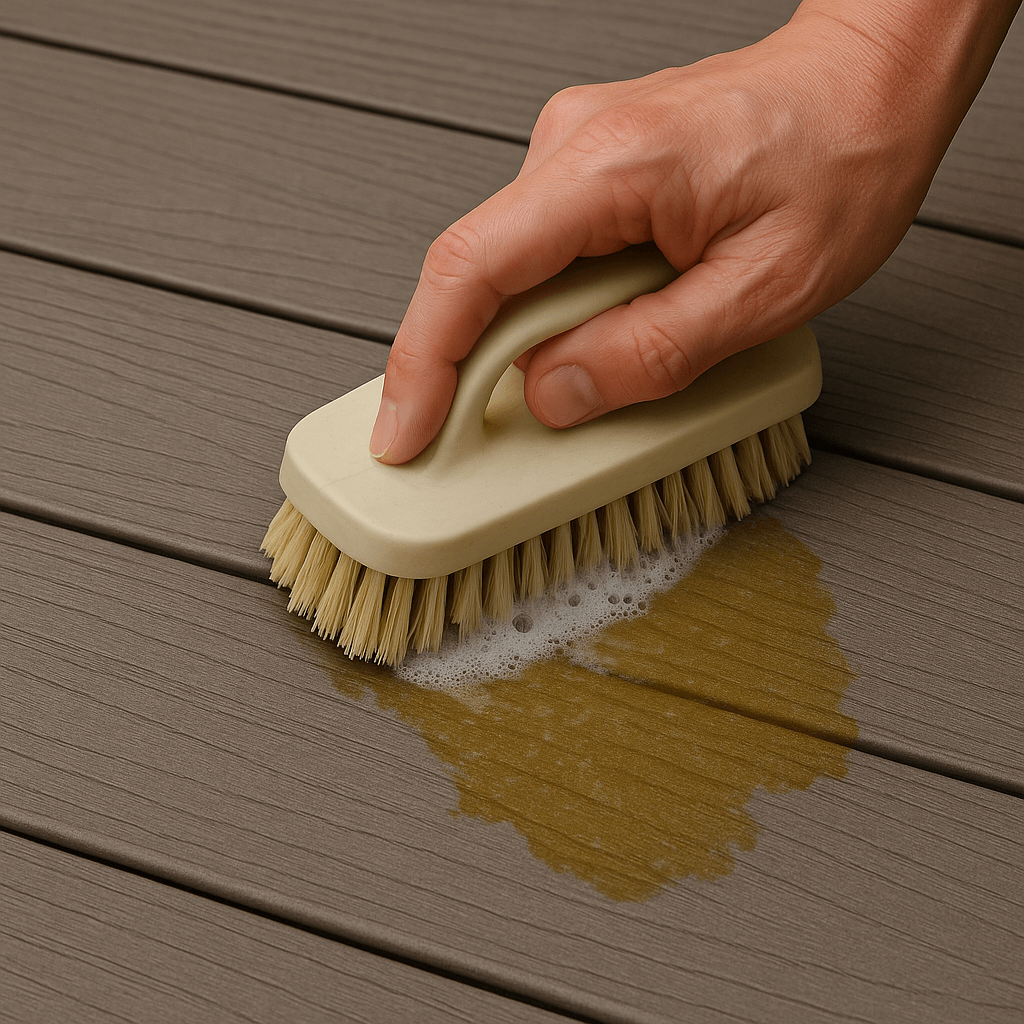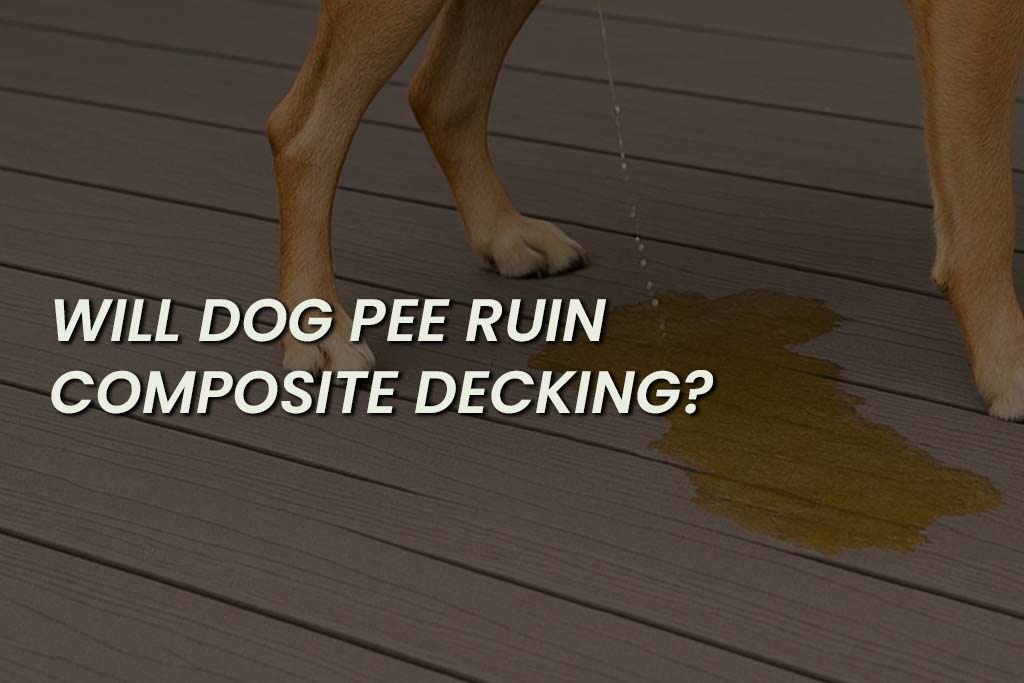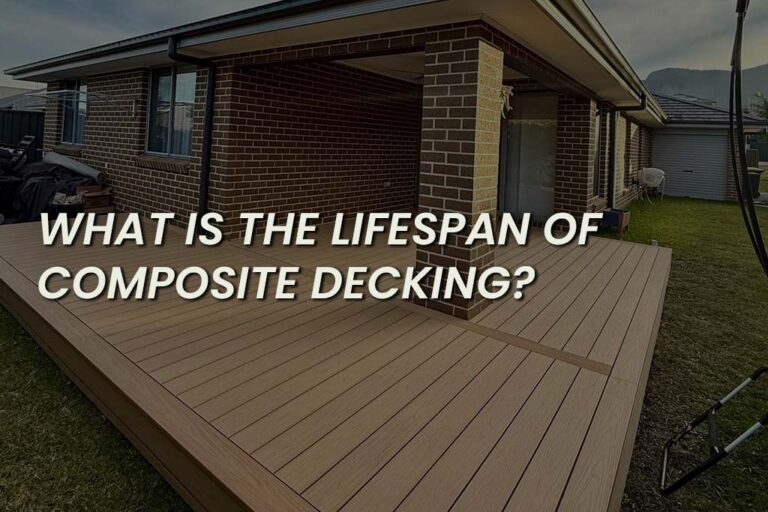Understanding Composite Decking and Its Surface

Composite decking is designed to handle daily life outside, blending wood fibres with recycled plastics to create boards that look like timber but resist wear. The outer surface often has a protective layer known as a “cap,” which makes it less porous than standard wood. This cap is what sets composite deck products apart, giving them an edge for busy families, pet owners, and anyone who wants a low-maintenance option.
These boards are made for Australian conditions. They are less likely to crack, splinter, or warp after exposure to rain, sun, and heavy use. The surface is engineered to keep out moisture and dirt, which means things like food spills, muddy shoes, and yes, pet accidents, are less of a problem than they would be with natural timber.
The capping technology isn’t just about strength, though. It’s designed to help the deck stay looking good. Unlike traditional wood, which absorbs liquids and can stain or grow mould, composite boards create a tougher barrier between daily mess and the material underneath. This makes composite a practical choice for homes where pets are part of the family.
How Does Dog Urine Affect Building Materials?
Dog urine is mostly water but contains salts, ammonia, and small amounts of other chemicals that can stain or break down some materials over time. On surfaces like untreated timber or porous concrete, repeated exposure can leave marks or even start to break down the material. These surfaces might also start to smell if the urine soaks in and isn’t cleaned away.
Many surfaces used outside, such as pavers or bricks, absorb moisture easily. If a dog uses these regularly, stains, odours, and even mould or algae growth can become a problem. Owners often notice yellowing or dark spots that are tough to remove. This is why pet owners sometimes worry about how well their deck will stand up to daily life.
Composite decking offers a different experience. Its blend of plastic and wood fibres means it doesn’t soak up moisture the same way timber does. The cap on many boards gives an extra layer of protection, reducing the risk of stains or long-term damage from repeated accidents.
Does Dog Pee Stain or Damage Composite Decking?
Dog urine doesn’t easily stain high-quality decking thanks to the cap’s resistance to moisture and chemicals. While the liquid may sit on the surface for a while, it usually doesn’t soak in, especially if the deck is properly installed and maintained. Quick clean-up almost always prevents any permanent mark.
There can still be issues if urine is left to dry and isn’t cleaned up promptly. Over time, the salts and minerals in the urine may leave a light residue or a slightly sticky patch. This is more likely on lighter composite decking colours, but even then, most marks come off with gentle cleaning.
Long-term damage from dog urine is rare. Composite decking is designed for resilience. Occasional accidents won’t harm the structure or the look of the boards. Regular cleaning and prompt attention to mess are the most important factors in keeping the deck fresh.
What Happens if Dog Urine is Left on Composite Decking?
If dog urine is left on the surface, the water will usually evaporate, leaving behind salts and other deposits. These may not be obvious at first but can become sticky or slightly discoloured if not washed away. Over time, a faint mark might develop, especially if accidents happen in the same spot.
Leaving any organic matter to dry out on a deck can attract dirt and bacteria. This can create a patch that feels different underfoot and may become slippery when wet. It can also create a lingering odour, even if the stain itself isn’t visible.
For owners of light-coloured or older composite boards, regular clean-up is even more important. Prompt action stops marks from forming and helps the deck maintain its colour. For darker or newer boards, the surface usually handles occasional accidents without trouble, but cleaning is still the best habit.
How Quickly Should Dog Pee Be Cleaned?
The best time to clean up after a pet is as soon as possible. The longer urine stays on the surface, the more likely it is to leave a residue. Wiping it up straight away with a damp cloth or a splash of water prevents almost all issues.
During busy days or in homes with more than one dog, it’s easy to miss an accident now and then. Setting up a daily sweep or quick rinse, especially in the areas where pets spend the most time, helps keep everything in top shape. Composite decking is forgiving, but quick action always pays off.
Sometimes, rain or hose water will wash away small accidents before anyone notices. Still, giving the area a closer check every few days ensures nothing is left to build up. This simple habit can stop stains, smells, and even surface stickiness before they start.
Cleaning Tips for Dog Urine on Decks

Cleaning composite decking is easy, even with pets. Start by wiping away as much of the liquid as possible using a paper towel or a soft cloth. A quick rinse with water usually removes anything left behind. For stubborn spots, use warm soapy water and a soft-bristled brush.
Avoid using harsh chemicals or high-pressure washers. These can strip the protective layer off some boards and cause long-term damage. Gentle cleaning products designed for outdoor surfaces or composite decking are safest for both the boards and any pets that might walk across them later.
Make sure the deck dries fully after cleaning, especially in shaded or damp corners. This stops any lingering odour and helps prevent mould. Regular maintenance, like sweeping and rinsing, makes spot cleaning much easier if an accident does happen.
Are Composite Decks More Resistant Than Timber?
Composite decking stands out when compared to timber for handling pet messes. Timber is porous and soaks up liquids quickly, which means stains and odours are much harder to remove. Even treated timber will eventually show marks and may develop soft or rotted patches if exposed to urine over time.
The plastic content in composite boards gives them a natural barrier against most household spills. This means they’re less likely to stain or hold smells, which is a relief for pet owners. Even when messes aren’t cleaned up straight away, composite usually comes clean with basic care.
This resistance isn’t just about surface messes. Composite boards are also less likely to warp or become rough after repeated washing. Where timber might splinter or become uneven, composite remains smooth and safe for paws and feet alike.
Will Dog Pee Cause Odours to Linger?
Odour is a concern for many pet owners, especially in small spaces or shaded decks where air doesn’t circulate much. Dog urine can cause a smell if it’s allowed to soak into porous surfaces. With composite decking, the lack of absorption helps prevent this, but odours can still develop if residues aren’t cleaned away.
If urine is left to dry out, the smell may be faint at first and get stronger over time. This is more likely in corners or under furniture where cleaning is less frequent. Regular sweeping and washing keep these areas fresh and stop any build-up of odours.
In most cases, a simple wash with soapy water is enough to get rid of any lingering smell. For persistent problems, products designed to neutralise pet odours can be used safely on composite decking, as long as they don’t contain harsh chemicals that could damage the surface.
Cleaning up messes is easier when the original decking installation includes proper drainage and airflow. These features help the surface dry quickly and stop smells from lingering after rain or accidents.
Long-Term Impact of Pets on Outdoor Areas
Having pets on the deck every day means more cleaning and the occasional bit of damage, but composite decking stands up to this better than most materials. Over the years, regular washing, quick clean-up, and basic maintenance keep the boards looking fresh.
Scratches from claws are less of an issue than on timber, as composite deck boards are less likely to splinter. The boards can be swept or hosed down without fear of water soaking in or creating rot. Occasional deeper cleans help remove any dirt or pet hair that builds up over time.
How to Prevent Dogs from Peeing on Decking
Some dogs naturally prefer grass or dirt, but others may use the deck if that’s where they spend the most time. To prevent this, set up a routine where pets are taken to a suitable spot before going onto the deck. Encouraging the use of specific areas with treats or praise helps create new habits.
Barriers or temporary fencing can keep pets off the deck when they aren’t supervised. For households with puppies or dogs still learning, using mats or puppy pads near the door helps catch accidents before they reach the boards. These can be cleaned more easily and stop any marks from forming.
Regular walks and outdoor time in dog-friendly spots take the pressure off decks and make accidents less likely. Over time, pets learn where they are expected to go, reducing the risk of accidents on the deck itself.
Can Dog Urine Cause Mould or Algae Growth?
Mould and algae are more likely to develop in damp, shady places, especially if there is organic material left behind. Dog urine, if not washed away, can provide food for mould or bacteria. On composite decking, the risk is lower because the surface is less porous, but it can still happen if cleaning is neglected.
Keeping the deck swept and rinsed helps prevent mould. If an accident happens, cleaning it up straight away removes both the urine and any residue that might feed mould. Areas with poor sunlight or little air flow should be checked more often for early signs of growth.
If mould or algae do appear, gentle cleaning with a soft brush and soapy water is usually enough. There are also products made for use on composite decking that can remove growth without harming pets or plants nearby.
Does Dog Pee Affect the Colour of Composite Boards?
Most modern composite decking is made with UV stabilisers and colour-fast technology, helping the boards keep their original look even after years outside. Occasional dog pee will not change the colour if it’s cleaned up promptly, as the cap layer resists staining.
If urine is left on light-coloured boards and dries out, a faint mark may be visible for a while. This usually comes off with cleaning. Older boards or those with a worn surface might be more prone to discolouration, but even then, the effect is much less than on timber.
To keep boards looking their best, regular maintenance and prompt clean-up are the most important steps. This simple approach works for most spills, including pet accidents, and keeps the deck fresh year after year.
What About Decking in Pet-Friendly Restaurants or Cafés?
Outdoor dining spaces, especially in pet-friendly venues, need to stand up to daily use by both people and their animals. Composite decking is popular in these settings because of its resistance to stains, smells, and heavy foot traffic. Staff can quickly clean up after accidents, keeping the area welcoming for all guests.
Using composite in commercial settings also means less time and money spent on repairs. Restaurant or café owners don’t have to worry about ongoing sealing or replacing boards stained by pets. The result is a more reliable outdoor space for events, families, and regular customers.
For venues with large dog traffic, regular cleaning schedules are key. This might include twice-daily sweeping and weekly washing, especially in corners and under tables. Using decking accessories like ramps and easy-clean mats helps with maintenance and access.
Are There Special Composite Decks for Pets?
Some composite decking brands promote extra-resilient boards designed with pets in mind. These may have enhanced scratch resistance or extra slip protection. For most families, standard capped composite boards are more than enough, offering the durability and cleanability needed for life with pets.
When choosing a product, look for boards with a tough outer cap, slip-resistant finish, and a colour that hides minor marks. These features make the deck more forgiving and keep it looking good, even if dogs or cats are part of daily life.
It’s worth talking to suppliers or reading product pages for any extra features that may suit households with multiple pets or large breeds. Some composite boards are made to handle even the roughest treatment, making them a smart long-term investment.
Long-Term Impact of Pets on Outdoor Areas
Having pets on the deck every day means more cleaning and the occasional bit of damage, but composite decking stands up to this better than most materials. Over the years, regular washing, quick clean-up, and basic maintenance keep the boards looking fresh.
Scratches from claws are less of an issue than on timber, as composite boards are less likely to splinter. The boards can be swept or hosed down without fear of water soaking in or creating rot. Occasional deeper cleans help remove any dirt or pet hair that builds up over time.
The biggest challenge for most pet owners is simply keeping up with the cleaning. Setting up a routine and having supplies nearby makes it easier to manage. Composite decking is designed to handle this kind of lifestyle, which is why it’s a popular choice for dog owners and families.
What to Do if a Dog Regularly Uses the Deck?
If a dog always uses the same spot on the deck, start by cleaning the area thoroughly with soapy water and a soft brush. Once the area is dry, try to block access with furniture or temporary fencing for a few days. Encourage the dog to use another spot outside by rewarding the correct behaviour.
Odour neutralisers designed for outdoor use can help remove any lingering scent, which may stop the dog from returning to the same spot. Repeating this process a few times usually breaks the habit.
If the behaviour continues, consider using a pet-safe repellent or a surface mat in the favourite spot. These products are easy to clean and protect the deck while you work on retraining the dog.
Other Pet Messes and Composite Decking
Dog pee isn’t the only concern for pet owners. Vomit, faeces, muddy paws, and food spills can also affect decks. Composite decking’s smooth surface and moisture resistance mean that all of these are easy to clean. Most messes come up with a quick rinse or a little soapy water.
Pet hair can build up in corners or under furniture. A soft broom or vacuum with a brush attachment works well for this. Regular sweeping and washing make bigger cleans less of a hassle, keeping the whole area tidy and safe for everyone.
If a pet brings bones or toys onto the deck, check for scratches. Most won’t leave marks, but soft pads under heavy furniture or regular inspection help prevent problems before they start.
Is Dog Pee a Concern With Australian Weather?
Australian weather is tough on outdoor surfaces, with intense sun, heavy rain, and, in some areas, salt or dust. Composite decking is built for these extremes, and pet messes are only a small part of what the boards are expected to handle.
Heat and sun can cause some stains to dry out quickly, but this doesn’t increase the risk of long-term damage. Frequent rain can actually help wash away small accidents, but shady or covered decks may need more regular attention to stop build-up.
Cleaning up pet mess is just part of the normal routine for most owners. Composite decking fits well into this lifestyle, making it a strong option for homes all over Australia.
How to Remove Odours From Composite Decks
If a smell lingers after cleaning, try washing the area again with warm soapy water and let it dry fully in the sun. Baking soda sprinkled over the spot and left for a few hours can also help absorb any stubborn odours. Vacuum or sweep away the powder before allowing pets back onto the deck.
There are also commercial products for neutralising pet smells. Choose those made for outdoor or composite surfaces, and test a small patch first to make sure there’s no impact on the colour or texture of the boards.
For best results, tackle smells as soon as they appear. Regular cleaning and letting the deck dry out in the sun will keep it fresh and inviting.
Are Some Decking Brands More Resistant Than Others?
All composite decking is more resistant to pet mess than timber, but some brands offer extra protection. Look for products with a fully capped surface and those that mention stain or moisture resistance on the product page. Some boards are also made thicker or with denser caps for higher durability.
Features like colour-fast technology, UV protection, and a slip-resistant finish add to the performance, making the boards even more suited to homes with pets. Reading the specifications and checking real-world reviews helps choose the right product for your needs.
Choosing a reputable local supplier helps ensure you get support and advice if there are any questions after installation. Suppliers can help match your needs to the right decking options, making the process simpler.
Best Practices for Deck Maintenance in Homes With Pets
Daily sweeping, regular washing, and prompt clean-up after any messes are the key steps. Keeping cleaning supplies handy, such as a soft broom, mild detergent, and a bucket, makes it easy to act quickly. Checking corners and under furniture helps prevent any build-up of dirt or smells.
Teach pets to use grass or garden areas whenever possible. For households with young animals, patience and positive reinforcement work best. Blocking off the deck while habits are set helps avoid repeated accidents.
Inspect the deck every few months for signs of wear, scratches, or loose boards. Tending to minor problems early prevents bigger issues later. With this approach, composite decking should stay fresh and strong for many years, even with pets around.
Common Mistakes to Avoid With Pets and Decks
Don’t use bleach or strong chemicals to clean pet messes, as these can damage the protective layer on composite boards. Stick to mild soap and water or products recommended for use with composite decking.
Avoid letting pet mess dry out for too long. Quick cleaning is much easier and stops stains or odours before they set. If your deck gets a lot of shade, check more often for mould or algae and clean up spills quickly.
Finally, don’t ignore repeated accidents. If a pet keeps using the deck, it’s worth addressing the behaviour, cleaning thoroughly, and making small changes to routine or layout to encourage better habits.
How Does Dog Pee Affect the Warranty?
Most composite decking warranties cover structural integrity, colour fade, and stain resistance. Occasional pet accidents won’t affect the warranty if the deck is cleaned and cared for as recommended by the manufacturer.
Long-term neglect or the use of harsh cleaning products can void some warranties. Always read the care instructions and follow best practices for cleaning and maintenance. If there are any doubts, contact the supplier or manufacturer for advice.
Keeping a record of cleaning or any repairs can help with any future warranty questions. Pet mess is a normal part of life, and composite decking is made to handle it when maintained correctly.
What Cleaning Products Are Safe for Composite Decking?
Mild, pH-neutral soap and water are the safest choice for cleaning both pet messes and general dirt. Products made for composite decking, which are free from harsh chemicals and abrasives, are also suitable.
Avoid anything with bleach, ammonia, or strong solvents. These can damage the cap or discolour the surface. For stubborn smells, baking soda is safe and effective. Always rinse well and allow the area to dry before letting pets back onto the deck.
Reading product labels and following the advice from your supplier ensures you keep the warranty intact and your deck looking its best.
Frequently Asked Questions About Dogs and Composite Decks
Does dog pee ruin composite decking?
No, composite decking is designed to resist stains and odours from occasional pet accidents. Quick cleaning is the key to preventing any long-term issues.
Will dog urine leave a mark if left for days?
If left for a long time, especially on light-coloured boards, a faint mark may develop. Most marks come off with gentle cleaning and a soft brush.
Can I use vinegar or baking soda on my deck?
Baking soda is safe for composite decking and can help remove odours. Vinegar should be diluted and used carefully, as high concentrations may dull the surface. Always test a small spot first.
How do I stop my dog from peeing on the deck?
Consistent training, positive reinforcement, and setting up a routine to use another spot work best. Temporary barriers and scent neutralisers can also help change habits.
What should I do if my deck starts to smell?
Wash the area with warm soapy water, let it dry, and use baking soda or an odour neutraliser as needed. Keeping up with regular cleaning prevents smells from returning.
Thinking of upgrading to pet-friendly decking? Explore our range of low-maintenance composite decking boards or contact us for expert advice.



